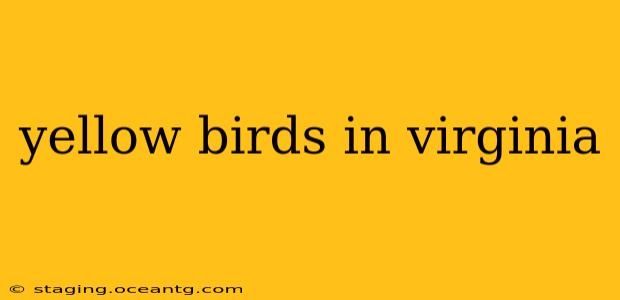Virginia's diverse habitats support a vibrant array of bird species, and among the most striking are its yellow birds. From the bright flashes of goldfinches to the subtle yellows of warblers, identifying these feathered friends can be a rewarding experience for birdwatchers of all levels. This guide will explore some of the common yellow birds found in Virginia, detailing their identification features, habitats, and behaviors.
What are some common yellow birds in Virginia?
Several yellow birds call Virginia home, each with unique characteristics. Some of the most frequently spotted include:
- American Goldfinch: Perhaps the most iconic yellow bird in Virginia, the American Goldfinch boasts a vibrant yellow body, black wings, and a distinctive notched tail. Males are particularly striking during breeding season, with a bright yellow plumage.
- Northern Cardinal (female): While the male Northern Cardinal is known for its vibrant red, the female displays a more subdued, yet beautiful, olive-brown and yellowish-brown plumage. This makes her a less obvious but still frequently seen yellow bird.
- Yellow-rumped Warbler (Myrtle Warbler): This warbler features a bright yellow rump (the area above the tail), along with yellow patches on its sides and a distinct yellow throat. Its back is often a more olive-green color.
- Yellow-throated Warbler: True to its name, this warbler showcases a striking yellow throat, often extending down its chest. It also features olive-green upperparts and yellowish flanks.
- Baltimore Oriole: A relatively large icterid, the Baltimore Oriole is a stunning bird with a mix of bright orange and black. However, females and immature males have more olive-yellow and black plumage, sometimes appearing predominantly yellowish-olive.
What are the best places to see yellow birds in Virginia?
The best places to spot these vibrant birds depend on the species and the time of year. However, some locations consistently offer excellent birdwatching opportunities:
- National Parks and Wildlife Refuges: These protected areas often provide diverse habitats and attract a wide range of bird species, including many yellow varieties. Look for areas with dense vegetation, such as forests, thickets, and wetlands.
- State Parks: Many state parks in Virginia offer well-maintained trails and excellent opportunities for birdwatching. Check the park's website or contact the park rangers for information on bird sightings and optimal viewing locations.
- Backyards and Urban Green Spaces: Surprisingly, even backyards and urban parks can attract yellow birds, especially if they offer appropriate food sources like feeders and native plants.
What time of year are yellow birds most visible in Virginia?
The visibility of yellow birds in Virginia varies depending on the species and their migration patterns.
- Migratory Species: Many warblers, including the Yellow-rumped and Yellow-throated Warblers, are migratory birds. They are most commonly seen during their spring and fall migrations, usually from April to May and September to October.
- Resident Species: Birds like the American Goldfinch are resident species, meaning they remain in Virginia year-round. However, their plumage and visibility can change seasonally. Males display brighter colors during breeding season (spring and summer).
What do yellow birds in Virginia eat?
The diets of yellow birds in Virginia vary widely based on the species. However, many share some common food sources:
- Seeds: American Goldfinches, for example, are primarily seed-eaters.
- Insects: Many warblers are insectivores, relying heavily on insects and other small invertebrates.
- Fruit and Berries: Some species may supplement their diet with fruits and berries, particularly during certain seasons.
How can I attract yellow birds to my backyard?
Attracting yellow birds to your backyard is possible with a little effort. Key strategies include:
- Providing food sources: Use bird feeders filled with appropriate seeds (nyjer for goldfinches) or suet.
- Planting native plants: Native plants provide nectar, fruits, and insects that attract various birds.
- Providing a water source: A birdbath or shallow dish of water is essential, especially during hot weather.
- Offering shelter: Plant shrubs and trees to provide cover and nesting sites.
By understanding the different species of yellow birds in Virginia, their preferred habitats, and their dietary needs, you can significantly enhance your chances of observing these beautiful creatures and contributing to citizen science efforts like bird counts. Remember to respect their natural habitat and enjoy the vibrant spectacle of nature.
